The reaction of Lynne Harper’s brother, Barry, to the acquittal of Steven Truscott of her murder is, I suppose, not altogether surprising, though it is ugly and disappointing. Barry Harper maintains that Steven Truscott is guilty of the rape and murder of his sister in 1959, when he was 15, she was 12, and Truscott was 14.
Barry’s evidence? Steven Truscott was “a tough kid”.
What’s more, Steven Truscott testified that he saw Lynne hitch a ride on Hwy 8, and get into a grey ’59 Chevy. On this score, Barry Harper says, “I could almost swear on a stack of Bibles that she never hitchhiked in her life.”
“Could almost” is another way of saying “can’t.”
What Barry Harper is saying here is that if he were standing before God, he could not look Him in the eye and swear his sister never hitchhiked, that she would not get in a car with a stranger to shorten a trip. He’s not sure. He would not stake his soul or his reputation on the assertion.
But he sure seems willing to stake Steven Truscott’s. Soul, reputation, freedom, even his life till his sentence was commuted.
I understand Barry Harper lost his sister in just about the most horrible way you can lose a family member. And naturally, he wants closure; he wants to know the cops got it right, the courts punished the murderer, that justice was done, at least in so far as it could be. I understand, too, that he must be disappointed now that it wasn’t. But I think it’s wrong, even malicious, of him to maintain what was clearly a legal fiction in the face of substantial evidence of judicial wrongdoing and lazy investigative work. Barry Harper needs to understand now — we all need to — that attitudes like his, based solely on prejudices and not real evidence, were what entrapped someone not guilty beyond a reasonable doubt, and, what’s worse, allowed someone toxic to remain at large among us.
Wednesday, August 29, 2007
Tuesday, August 28, 2007
The sleep of the innocent
Twelve hours ago, as I write this, Steven Truscott was, officially, in the eyes of the community, a convicted murderer. Tonight, he is not.
The Ontario Court of Appeal, just before 11 a.m. this morning, published its decision on his case: his 1959 trial was a miscarriage of justice, and that if tried to today, with the evidence available both at the time and subsequently, a jury's reasonable doubt would not allow them to convict. His conviction, therefore, was set aside, and he was acquitted of the murder of Lynne Harper.
This is a remarkable case. Steven Harper was just 14 when he was tried, convicted, and sentenced to hang for the murder, on June 9, 1959, of 12-year-old Lynne Harper in Goderich, Ontario. In early 1960, Parliament commuted his sentence to life in prison. He was paroled in 1969, was given a new name, married, and had three children. A millwright, he has been a model citizen ever since. In 2000, after talking it over with his family and close friends, he emerged from seclusion, took back his name, and began the fight to clear that name. From the beginning, he has maintained his innocence. For decades, most Canadians have believed in it too. Tonight, it's a matter of law, official, at last. As his wife, Marlene, put it in the fifth estate's ground-breaking 2000 documentary, "Every night he goes to bed as a convicted murderer and every morning he wakes up as a convicted murderer and why should he be?"
Not tonight.
Not tomorrow morning.
When I was 14 myself in the early 80s, I read The Steven Truscott Story, as told by Steven Truscott to Bill Trent. All my life I'll remember sitting in math class, waiting for the teacher to arrive and reading Steven's account of waiting to be hanged the winter of 1959. There was a tree outside his cell, and he played a risk game with himself: if any of the leaves were left on the tree by New Year's, he wouldn't be hanged. Every morning he got up to see how many leaves, "traitors", he called them, had fallen off during the night. I could remember playing such games myself concerning matters beyond my control. I completely identified with him, though I could not then, and cannot now, imagine what it was like for him.
All my life, there has been something just a bit wrong with Canada, just a bit off-kilter, because we all knew in our hearts the man was not guilty, but our country said he was. Something was out of joint. Today, this afternoon while I was driving and listening to Steven Truscott address the public, I felt something had changed about Canada. Something had been put right at last. It was just a little bit new; not the same place I woke up in. That was a subtly powerful feeling.
I confess that I was disappointed that the court acquitted him, but would not go that last couple of inches and declare him innocent. I didn't understand what that entailed. A friend of mine, who is a provincial justice archivist, explained the mechanics of it to me, and I share that now with you…
Truscott has come as close as he can to his goal. While some may see a verdict of "acquitted of all charges" as another way of saying that he was guilty but there was not enough evidence to prove it, the legal definition of the word is very specific (i.e., "To be publicly declared free of a claim of criminal wrongdoing or an imputation of guilt"). He wanted a declaration of innocence from the courts but that could only be issued if there was an accompanying conviction or admission of guilt from the real murder of Lynne Harper -- something which is not going to happen at this late date.
Also, the Ontario Court of Appeal traditionally does not have that power. It hears cases only if there has been a suggestion that an error of evidence or an error of law had occurred during the previous trial. In Truscott's case, they permitted the appeal to be heard due to errors of evidence (the fact that it had already been appealed to the Supreme Court of Canada and the verdict upheld had little bearing as the SCC only deals with errors of law, not of evidence). Indeed, the Ontario Court of Appeal granted Truscott the highly unique privilege of not only reviewing the original evidence but -- rather than ordering a new trial as would be the proper response -- the Appellate Justices reviewed the newly discovered evidence and heard the new witnesses themselves. This happens only a few times every century and requires the permission of both the Attorney General and the Chief Justice.
Either way, a travesty of justice has finally been corrected and the entire sorry affair can be handed to the annals of history and the next flurry of "now it can be revealed" publications.
Good for Truscott for never giving up. He is now the judicial equivalent of Terry Fox.
I told him I agreed; Steven Truscott is a hero, like Terry, except it was given to Steven, as it wasn't to Terry, to see his goal realized while he lives. What Steven Truscott did and endured, he did not just for himself, but for every Canadian who may one day face false accusations, rushed police investigations, harried court officers and an overburdened legal system eager to process cases and move on. No short cuts. They ruin the lives of the innocent, and, what may be worse for us all, let the truly guilty walk free. No one knows for sure who killed Lynne Harper, though there are favourite suspects, but we now know it wasn't Steve.
But that means, after 48 years, it's almost certain her killer got away with it, stealing Steve's good name and taking it with him to the grave.
Until now.
Congratulations, Mr. Truscott, to you, your family, and your supporters. And here's to our country. It grew up a little today.
The Ontario Court of Appeal, just before 11 a.m. this morning, published its decision on his case: his 1959 trial was a miscarriage of justice, and that if tried to today, with the evidence available both at the time and subsequently, a jury's reasonable doubt would not allow them to convict. His conviction, therefore, was set aside, and he was acquitted of the murder of Lynne Harper.
This is a remarkable case. Steven Harper was just 14 when he was tried, convicted, and sentenced to hang for the murder, on June 9, 1959, of 12-year-old Lynne Harper in Goderich, Ontario. In early 1960, Parliament commuted his sentence to life in prison. He was paroled in 1969, was given a new name, married, and had three children. A millwright, he has been a model citizen ever since. In 2000, after talking it over with his family and close friends, he emerged from seclusion, took back his name, and began the fight to clear that name. From the beginning, he has maintained his innocence. For decades, most Canadians have believed in it too. Tonight, it's a matter of law, official, at last. As his wife, Marlene, put it in the fifth estate's ground-breaking 2000 documentary, "Every night he goes to bed as a convicted murderer and every morning he wakes up as a convicted murderer and why should he be?"
Not tonight.
Not tomorrow morning.
When I was 14 myself in the early 80s, I read The Steven Truscott Story, as told by Steven Truscott to Bill Trent. All my life I'll remember sitting in math class, waiting for the teacher to arrive and reading Steven's account of waiting to be hanged the winter of 1959. There was a tree outside his cell, and he played a risk game with himself: if any of the leaves were left on the tree by New Year's, he wouldn't be hanged. Every morning he got up to see how many leaves, "traitors", he called them, had fallen off during the night. I could remember playing such games myself concerning matters beyond my control. I completely identified with him, though I could not then, and cannot now, imagine what it was like for him.
All my life, there has been something just a bit wrong with Canada, just a bit off-kilter, because we all knew in our hearts the man was not guilty, but our country said he was. Something was out of joint. Today, this afternoon while I was driving and listening to Steven Truscott address the public, I felt something had changed about Canada. Something had been put right at last. It was just a little bit new; not the same place I woke up in. That was a subtly powerful feeling.
I confess that I was disappointed that the court acquitted him, but would not go that last couple of inches and declare him innocent. I didn't understand what that entailed. A friend of mine, who is a provincial justice archivist, explained the mechanics of it to me, and I share that now with you…
Truscott has come as close as he can to his goal. While some may see a verdict of "acquitted of all charges" as another way of saying that he was guilty but there was not enough evidence to prove it, the legal definition of the word is very specific (i.e., "To be publicly declared free of a claim of criminal wrongdoing or an imputation of guilt"). He wanted a declaration of innocence from the courts but that could only be issued if there was an accompanying conviction or admission of guilt from the real murder of Lynne Harper -- something which is not going to happen at this late date.
Also, the Ontario Court of Appeal traditionally does not have that power. It hears cases only if there has been a suggestion that an error of evidence or an error of law had occurred during the previous trial. In Truscott's case, they permitted the appeal to be heard due to errors of evidence (the fact that it had already been appealed to the Supreme Court of Canada and the verdict upheld had little bearing as the SCC only deals with errors of law, not of evidence). Indeed, the Ontario Court of Appeal granted Truscott the highly unique privilege of not only reviewing the original evidence but -- rather than ordering a new trial as would be the proper response -- the Appellate Justices reviewed the newly discovered evidence and heard the new witnesses themselves. This happens only a few times every century and requires the permission of both the Attorney General and the Chief Justice.
Either way, a travesty of justice has finally been corrected and the entire sorry affair can be handed to the annals of history and the next flurry of "now it can be revealed" publications.
Good for Truscott for never giving up. He is now the judicial equivalent of Terry Fox.
I told him I agreed; Steven Truscott is a hero, like Terry, except it was given to Steven, as it wasn't to Terry, to see his goal realized while he lives. What Steven Truscott did and endured, he did not just for himself, but for every Canadian who may one day face false accusations, rushed police investigations, harried court officers and an overburdened legal system eager to process cases and move on. No short cuts. They ruin the lives of the innocent, and, what may be worse for us all, let the truly guilty walk free. No one knows for sure who killed Lynne Harper, though there are favourite suspects, but we now know it wasn't Steve.
But that means, after 48 years, it's almost certain her killer got away with it, stealing Steve's good name and taking it with him to the grave.
Until now.
Congratulations, Mr. Truscott, to you, your family, and your supporters. And here's to our country. It grew up a little today.
Sunday, August 19, 2007
Weston bridges over the Humber, then and now
Part of the reason I'm here in the first place was a mention of Flindon Road bridge... which I gather was itself prompted by a photo I took in May of 2006! Ironies abound.
I'd been meaning to go out there again for a long time, and a couple of weeks ago I did, largely because in studying some maps, I came to realize that the ho-hum footbridge that a little to the west that I'd seen and hiked to that spring was once, in fact, the bridge that carried Albion Road, so I wanted to go back there and see that as well.
After that, last Friday's trip to the City Archives sparked my interest in Blondin Avenue, and while I was there, I decided to explore the far side of what was once Flindon Road as well, on the Etobicoke side. Here are shots from both those trips.
First, the requisite background material. These are shots that show the progression of Humber crossings. The means across has been moving steadily southwest for the past 50 years or so.
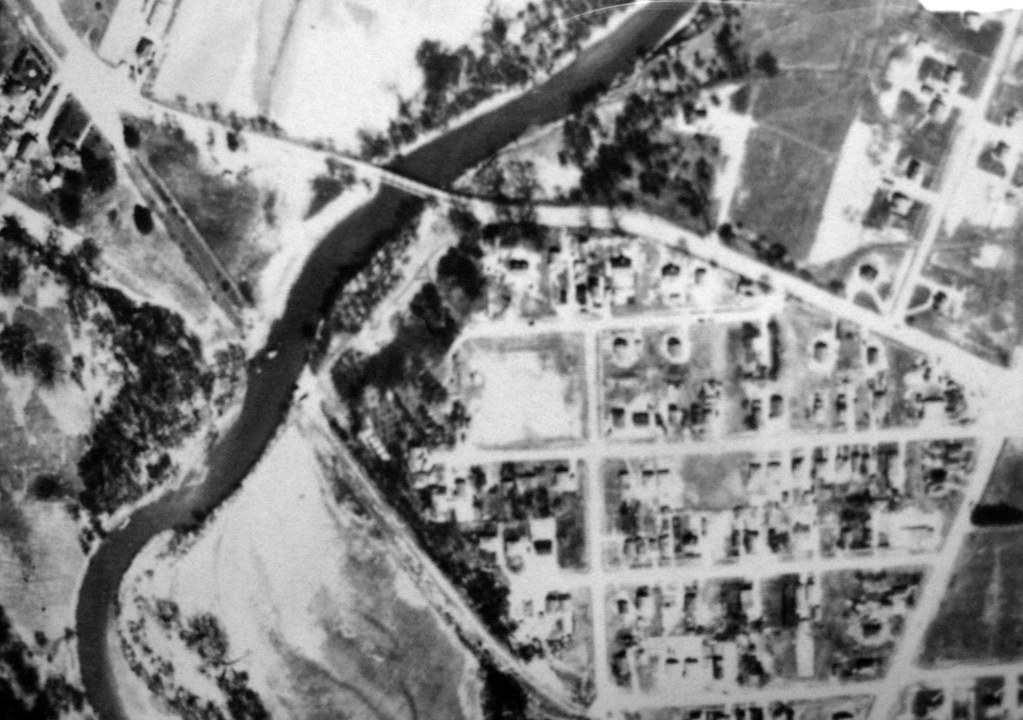
1950. The biggest surprise I got here is that not only was there indeed a Flindon Road bridge (it's been on maps, but this was the first time I'd seen it in a photo), but there's no other crossing! The bridge at Albion Road doesn't exist. You can see broad hints of Albion Road's course, but no bridge. I don't know if this is just the rough-in for the road, or that Albion already existed, but had either never had a bridge, or it had been somehow destroyed. That's hard to imagine, though. This was still several years before Hurricane Hazel.
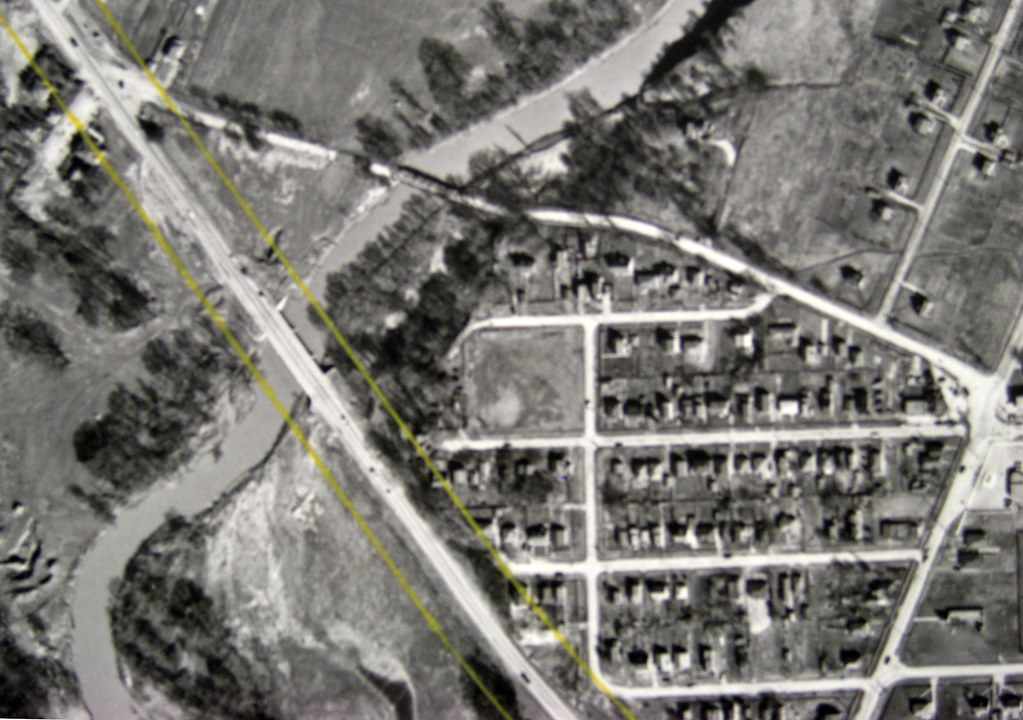
1956. The first Albion Road bridge has been built, but it still shares the duty of carrying traffic over the Humber with Flindon Road. The interesting thing is that today, neither of these bridges serves this purpose. The latter is, of course, completely gone, and the former has been reduced to carrying pedestrian and bike traffic.

1959. Not much has changed since 1956, aside from the addition of a scattered handful of new homes.
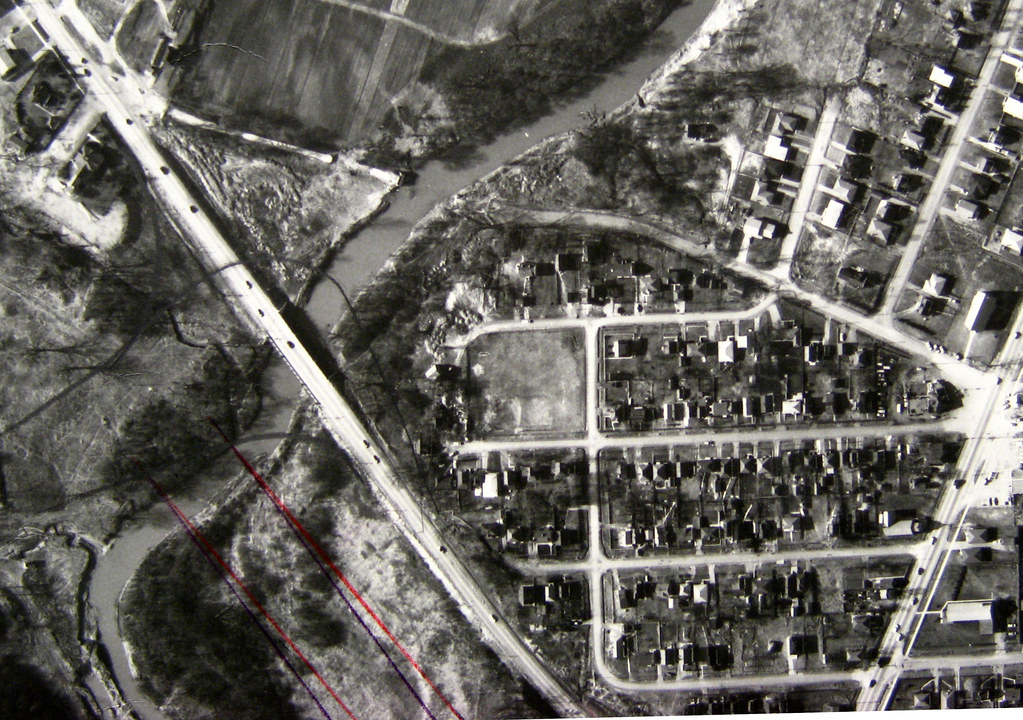
1962. The year before, Flindon Road bridge was still in the aerial shots. But in 1962, it's been removed. Note the highly evident abutment on the northwest Etobicoke side. It's completely gone today. If you look closely, you can see two red pencil marks drawn by a planner that predict today's course of Albion Road and where the second bridge was to be built.
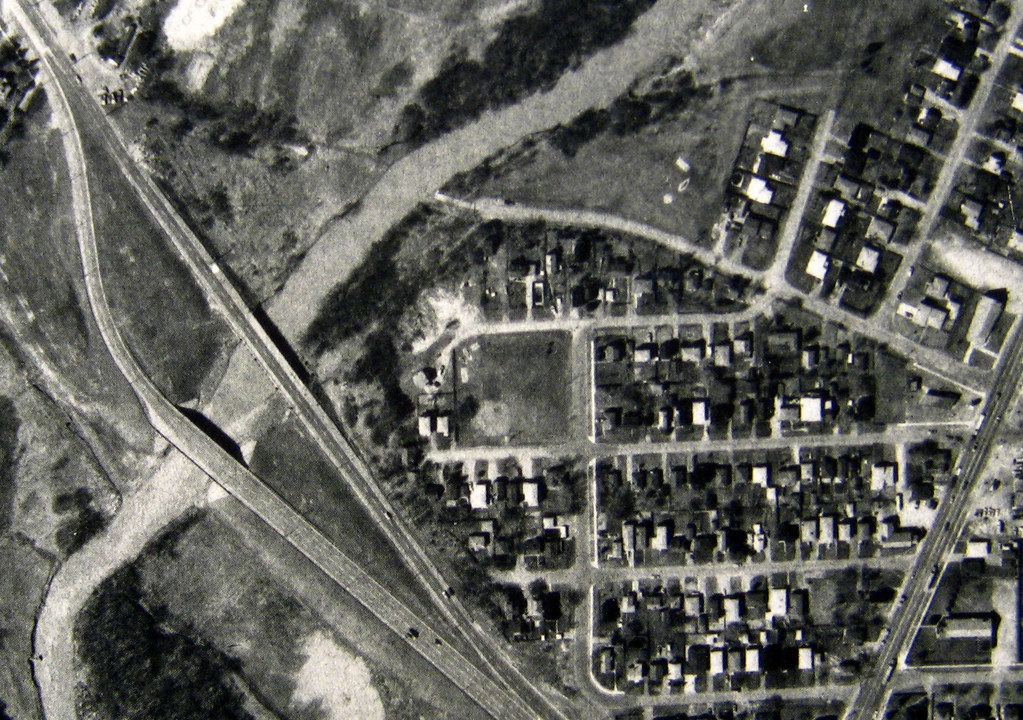
1975. Sometime after 1970 (when it doesn't yet appear in aerial shots) and 1975, the second bridge was built. Northbound traffic on Albion uses the old bridge, and southbound uses the new. It was to remain like that until sometime in the 1990s. As for Flindon, you can see that a few hints of its course still remain on the Etobicoke side.
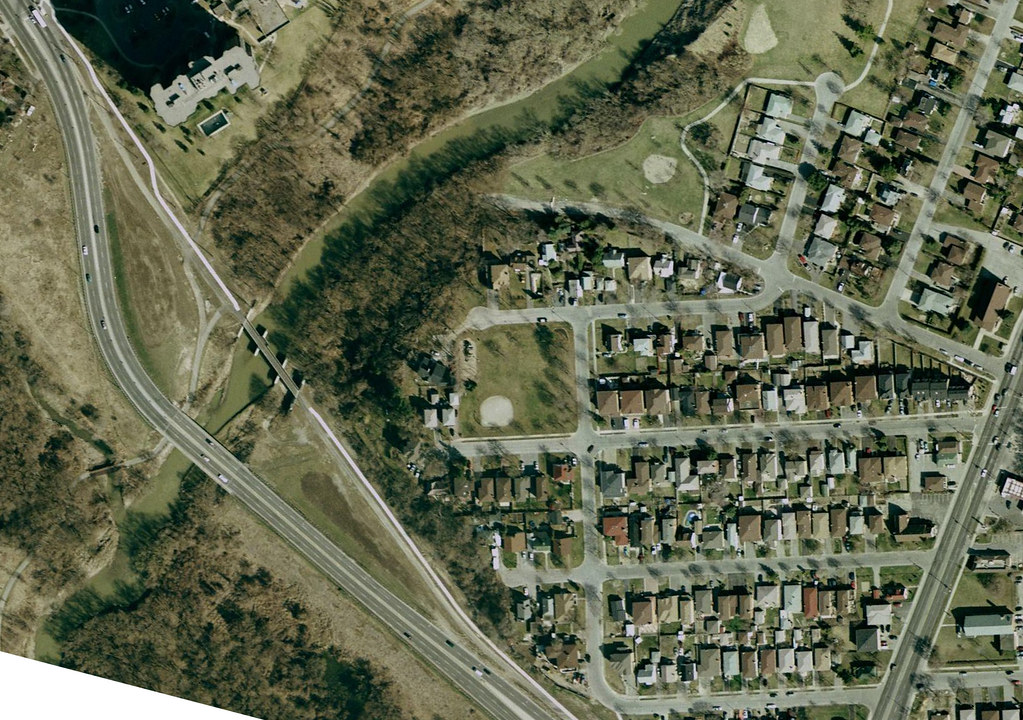
2006. The old bridge has been retired to its current role carrying pedestrians and bicyclists. The new bridge carries four lanes; two northbound, two southbound. Flindon has completely vanished on the Etobicoke side.

August, 2007. This is approaching the very end of Flindon Road on the North York side, looking across the Humber into Etobicoke at the opposite bank, where no parallel structure exists.
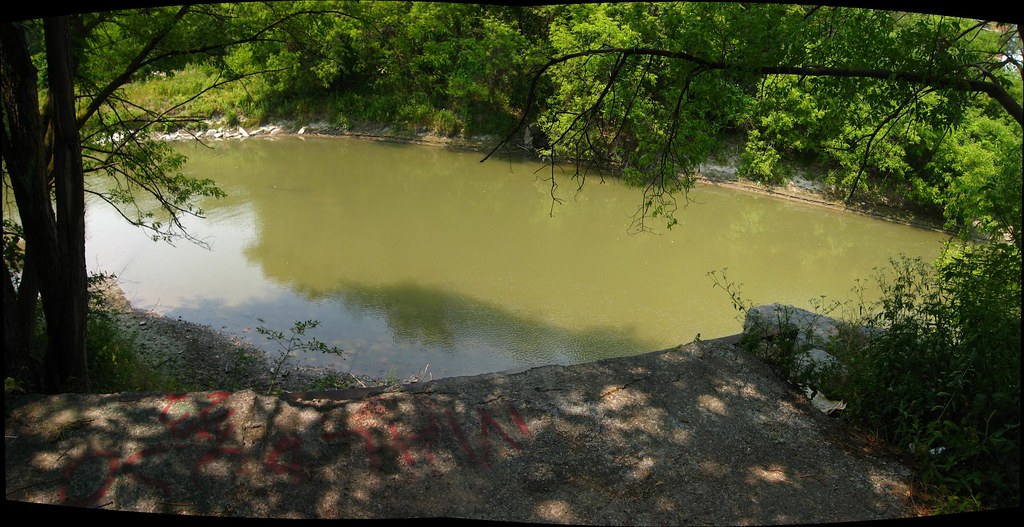
The last few inches of Flindon Road (it's actually closed many yards behind me, of course). But don't worry! All you have to do is make sure the De Lorean is going 88 miles per hour and set to 1961 before you reach this spot, and everything will be fine!

Between bridge locations at the river level. The small clearing at the extreme right on the far bank is where Flindon Road bridge once crossed into Etobicoke. Off to my left, out of sight, is the first of of the Albion Road bridges.
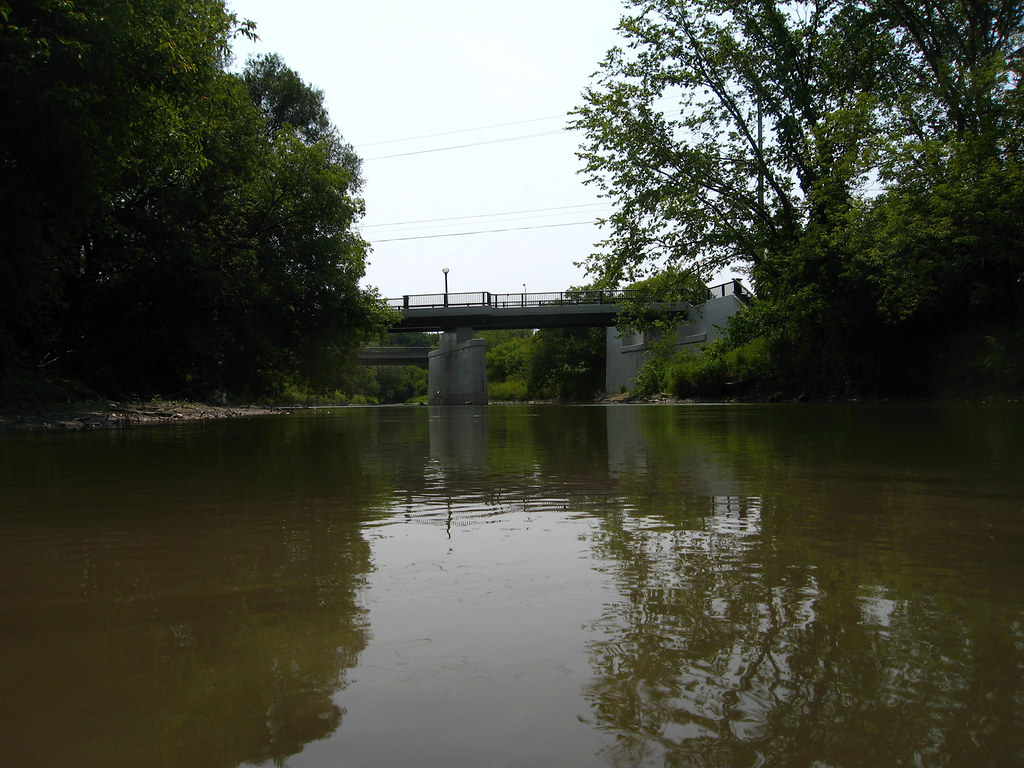
The first of the Albion Road bridges, seen from the river level. Beyond it, you can just glimpse the new, current traffic bridge.

Closer still, this is the first Albion Road bridge. It was the cause of the demise of the Flindon Road bridge, but itself has fallen victim to the success of the newer Albion Road bridge beyond it.

The is the first Albion Road bridge, facing west into Etobicoke. From the 50s to the early 70s, this carried automobile traffic both ways. From the early 70s to sometime in the 90s, it carried traffic heading northwest, facing in the direction I'm looking in the shot. After that, it became what you see here... a small bridge reduced to barely one lane in width for strollers, joggers, and cyclists.
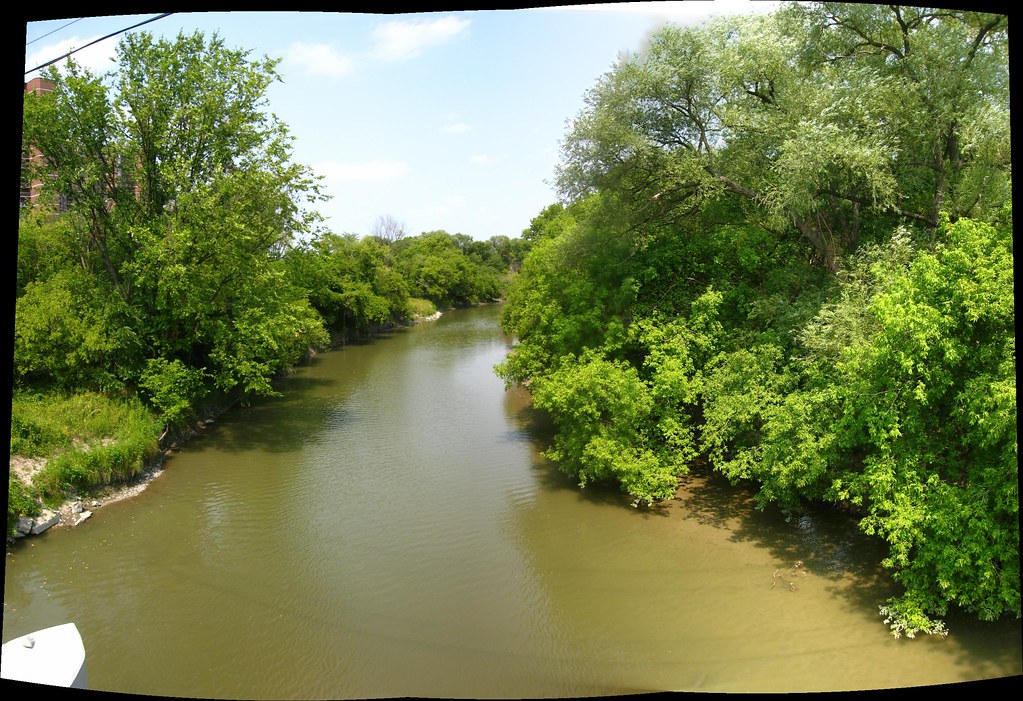
Looking northeast upstream along the Humber from the first Albion Road bridge. Just about dead centre is the little open lip on the west bank where Flindon Road used to cross the river.
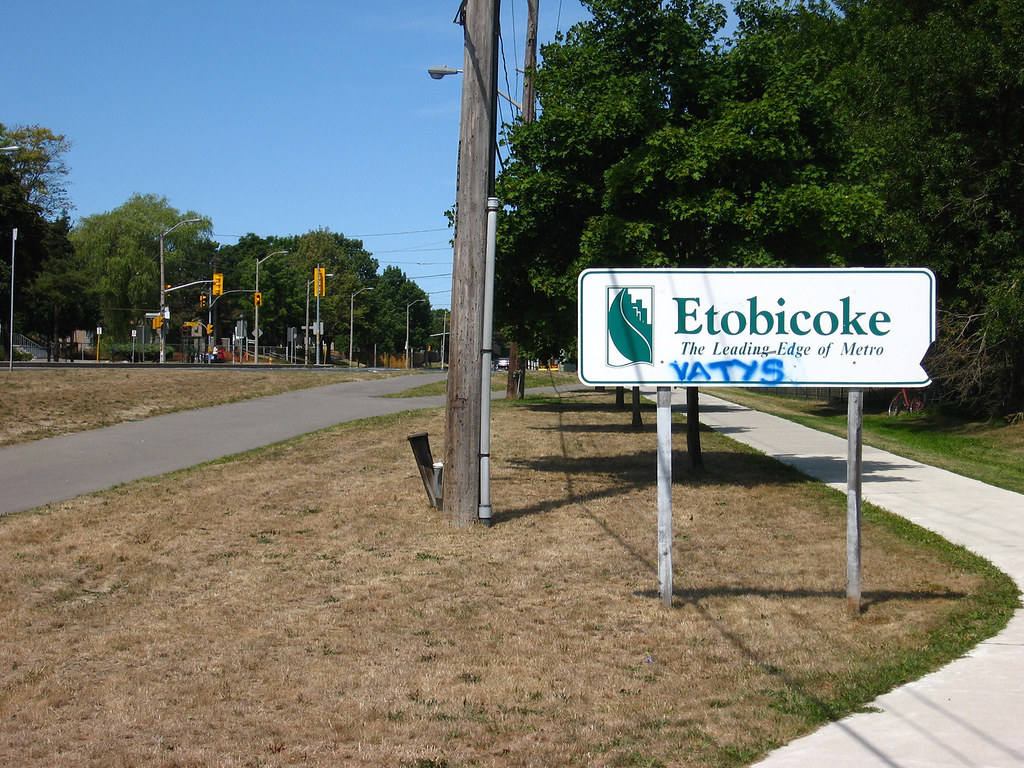
This sign is almost pathetic in its anachronism. At one time, maybe a little over ten years ago, this sign would have been at the very roadside of Albion Road, welcoming drivers who passed by just a few yards to the left. Now all the traffic is much further away, and it's doubtful if the sign can even been seen. Furthermore, Etobicoke, and Metro, at least as such, themselves ceased to exist just about ten years ago.
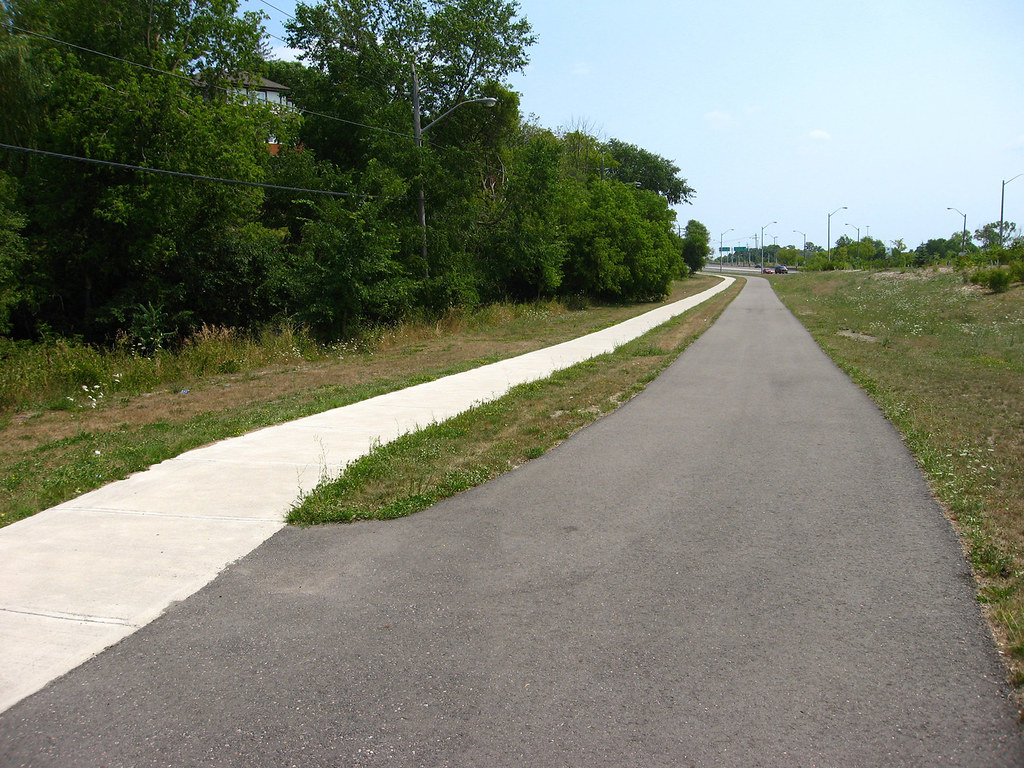
This looks back to the southeast with the first Albion Road bridge just behind me. Not too long ago, I would have been standing facing oncoming traffic. This was the route you took heading northwest to cross the Humber on Albion. Even further back in time, it was the route of Albion Road, period.
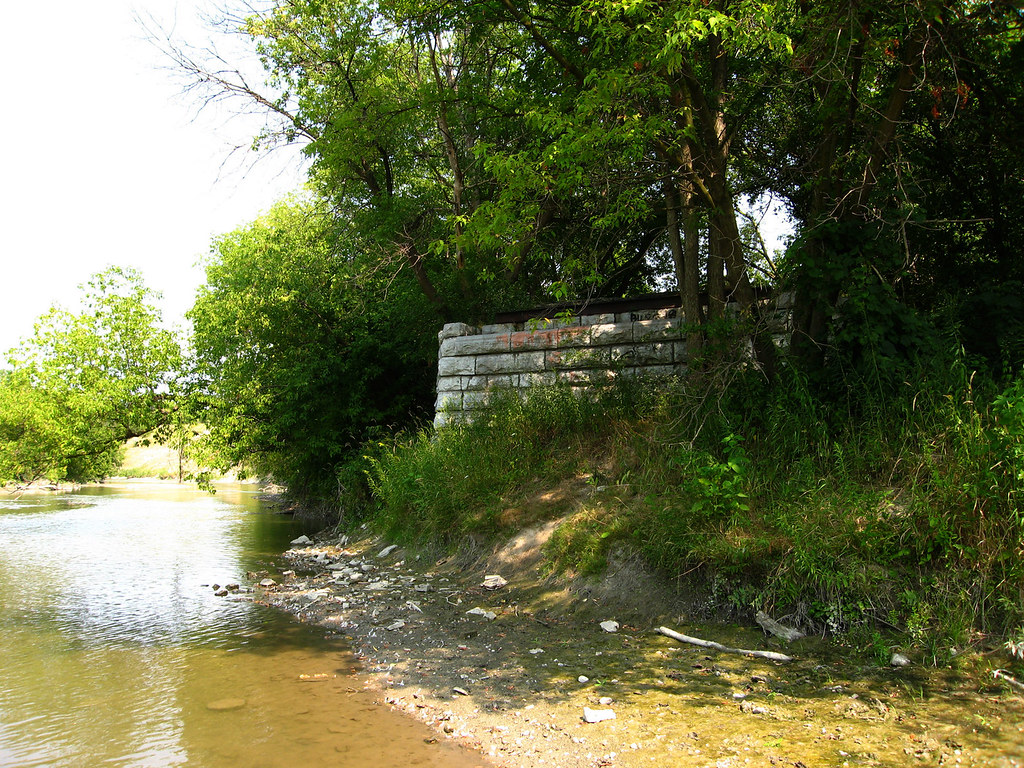
A look at the North York abutment of Flindon Road bridge from the river.

Here I'm standing on the Etobicoke bank pretty much exactly where the western abutment of Flindon Road once was, looking across at the North York side.
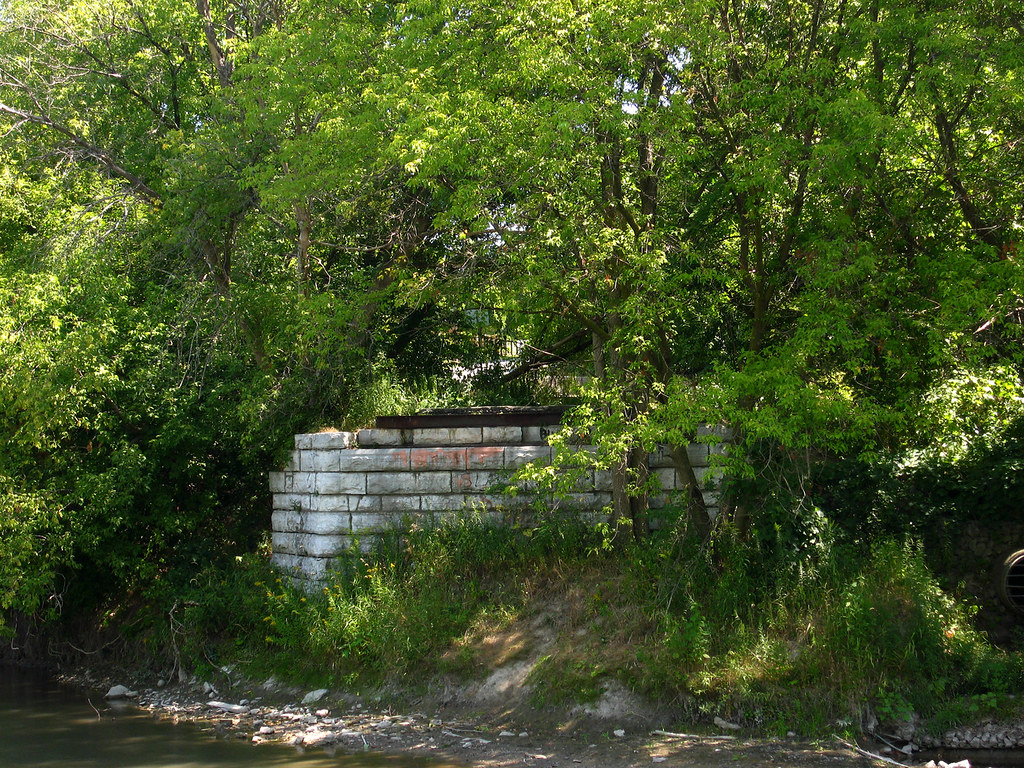
A tighter shot of the North York abutment seen from the Etobicoke Flindon clearing.
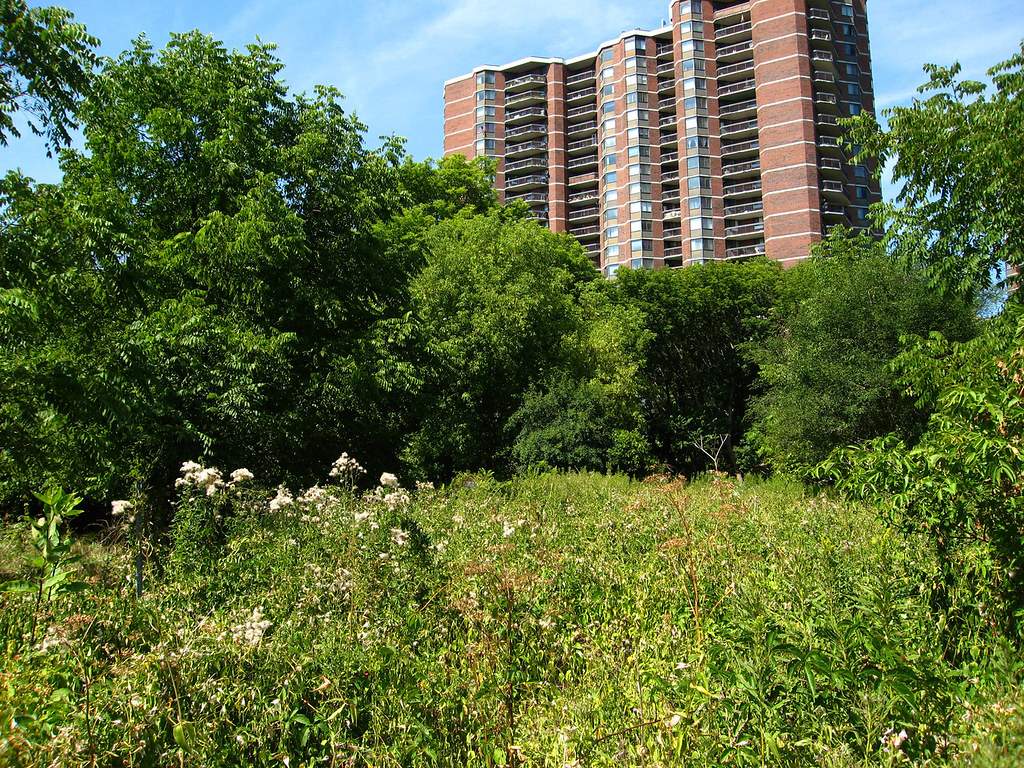
And turning around, this is the clearing. Once upon a time, fifty years ago, this was the road up from the Humber into Etobicoke. Beyond the screen of trees is a park pathway.

Standing on the grave of Flindon Road bridge, looking downstream at the Albion Road bridge that condemned it.
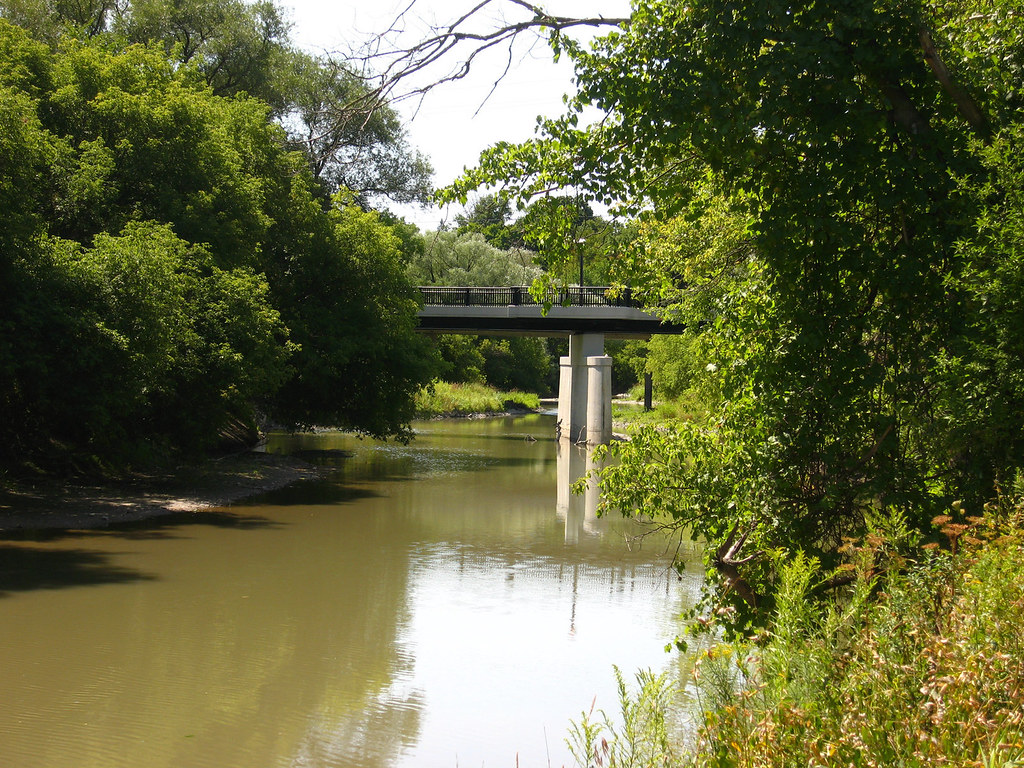
A tighter view of the first Albion Road bridge seen from the Etobicoke side Flindon Road clearing.
Photographs of Flindon Road bridge during the flooding caused by Hurricane Hazel...

Another view of the same bridge... the notation where I found it indicates that the view looks west, so my guess was wrong. I started wondering that when I noticed all the junk was piled up on the right side, which would be upstream. Oh well.

It's possible that this was the original Albion Road bridge, predating even the bridge at Flindon Road. The photo dates from about a hundred years ago. If so, this bridge would have stood where the current foot bridge crossing is today. A lot of water under the bridge... pardon the pun.

I'd been meaning to go out there again for a long time, and a couple of weeks ago I did, largely because in studying some maps, I came to realize that the ho-hum footbridge that a little to the west that I'd seen and hiked to that spring was once, in fact, the bridge that carried Albion Road, so I wanted to go back there and see that as well.
After that, last Friday's trip to the City Archives sparked my interest in Blondin Avenue, and while I was there, I decided to explore the far side of what was once Flindon Road as well, on the Etobicoke side. Here are shots from both those trips.
First, the requisite background material. These are shots that show the progression of Humber crossings. The means across has been moving steadily southwest for the past 50 years or so.

1950. The biggest surprise I got here is that not only was there indeed a Flindon Road bridge (it's been on maps, but this was the first time I'd seen it in a photo), but there's no other crossing! The bridge at Albion Road doesn't exist. You can see broad hints of Albion Road's course, but no bridge. I don't know if this is just the rough-in for the road, or that Albion already existed, but had either never had a bridge, or it had been somehow destroyed. That's hard to imagine, though. This was still several years before Hurricane Hazel.

1956. The first Albion Road bridge has been built, but it still shares the duty of carrying traffic over the Humber with Flindon Road. The interesting thing is that today, neither of these bridges serves this purpose. The latter is, of course, completely gone, and the former has been reduced to carrying pedestrian and bike traffic.

1959. Not much has changed since 1956, aside from the addition of a scattered handful of new homes.

1962. The year before, Flindon Road bridge was still in the aerial shots. But in 1962, it's been removed. Note the highly evident abutment on the northwest Etobicoke side. It's completely gone today. If you look closely, you can see two red pencil marks drawn by a planner that predict today's course of Albion Road and where the second bridge was to be built.

1975. Sometime after 1970 (when it doesn't yet appear in aerial shots) and 1975, the second bridge was built. Northbound traffic on Albion uses the old bridge, and southbound uses the new. It was to remain like that until sometime in the 1990s. As for Flindon, you can see that a few hints of its course still remain on the Etobicoke side.

2006. The old bridge has been retired to its current role carrying pedestrians and bicyclists. The new bridge carries four lanes; two northbound, two southbound. Flindon has completely vanished on the Etobicoke side.

August, 2007. This is approaching the very end of Flindon Road on the North York side, looking across the Humber into Etobicoke at the opposite bank, where no parallel structure exists.

The last few inches of Flindon Road (it's actually closed many yards behind me, of course). But don't worry! All you have to do is make sure the De Lorean is going 88 miles per hour and set to 1961 before you reach this spot, and everything will be fine!


Between bridge locations at the river level. The small clearing at the extreme right on the far bank is where Flindon Road bridge once crossed into Etobicoke. Off to my left, out of sight, is the first of of the Albion Road bridges.

The first of the Albion Road bridges, seen from the river level. Beyond it, you can just glimpse the new, current traffic bridge.

Closer still, this is the first Albion Road bridge. It was the cause of the demise of the Flindon Road bridge, but itself has fallen victim to the success of the newer Albion Road bridge beyond it.

The is the first Albion Road bridge, facing west into Etobicoke. From the 50s to the early 70s, this carried automobile traffic both ways. From the early 70s to sometime in the 90s, it carried traffic heading northwest, facing in the direction I'm looking in the shot. After that, it became what you see here... a small bridge reduced to barely one lane in width for strollers, joggers, and cyclists.

Looking northeast upstream along the Humber from the first Albion Road bridge. Just about dead centre is the little open lip on the west bank where Flindon Road used to cross the river.

This sign is almost pathetic in its anachronism. At one time, maybe a little over ten years ago, this sign would have been at the very roadside of Albion Road, welcoming drivers who passed by just a few yards to the left. Now all the traffic is much further away, and it's doubtful if the sign can even been seen. Furthermore, Etobicoke, and Metro, at least as such, themselves ceased to exist just about ten years ago.

This looks back to the southeast with the first Albion Road bridge just behind me. Not too long ago, I would have been standing facing oncoming traffic. This was the route you took heading northwest to cross the Humber on Albion. Even further back in time, it was the route of Albion Road, period.

A look at the North York abutment of Flindon Road bridge from the river.

Here I'm standing on the Etobicoke bank pretty much exactly where the western abutment of Flindon Road once was, looking across at the North York side.

A tighter shot of the North York abutment seen from the Etobicoke Flindon clearing.

And turning around, this is the clearing. Once upon a time, fifty years ago, this was the road up from the Humber into Etobicoke. Beyond the screen of trees is a park pathway.

Standing on the grave of Flindon Road bridge, looking downstream at the Albion Road bridge that condemned it.

A tighter view of the first Albion Road bridge seen from the Etobicoke side Flindon Road clearing.
Photographs of Flindon Road bridge during the flooding caused by Hurricane Hazel...

Another view of the same bridge... the notation where I found it indicates that the view looks west, so my guess was wrong. I started wondering that when I noticed all the junk was piled up on the right side, which would be upstream. Oh well.

It's possible that this was the original Albion Road bridge, predating even the bridge at Flindon Road. The photo dates from about a hundred years ago. If so, this bridge would have stood where the current foot bridge crossing is today. A lot of water under the bridge... pardon the pun.

Monday, August 13, 2007
You didn't hear it here first, probably
Apparently, US presidential candidate Barack Obama thinks NAFTA is a flawed deal, and if elected, he would get right on the horn and “immediately call the president of Mexico, the president of Canada, to try to amend NAFTA…”
Ah, after all these years of having idiots who don’t know a thing about the world outside their borders running the United States and ignorantly kicking over bee hives around the world, how refreshing it is to see a presidential front-runner who knows something about the rest of the planet…
Okay, look. I’m not saying that the man is obliged to know what the capital of Saskatchewan is (though it might be nice), or who’s the current mayor of Paris, or anything that granular, but Jesus Christ… we’re talking about winding up President of the United States of Atomic Bombs here. If you don’t even know the basics about the people right next door in the one country on Earth most like your own, I’m sorry, you have no business shooting for the presidency. You just don’t know enough. Aim for Secretary of the Interior or something where you’re not dealing with the other 95% of mankind.
Well, to his credit, at least he knows who’s in NAFTA and didn’t wind up calling for the King of Cuba to come work something out.
Ah, after all these years of having idiots who don’t know a thing about the world outside their borders running the United States and ignorantly kicking over bee hives around the world, how refreshing it is to see a presidential front-runner who knows something about the rest of the planet…
Okay, look. I’m not saying that the man is obliged to know what the capital of Saskatchewan is (though it might be nice), or who’s the current mayor of Paris, or anything that granular, but Jesus Christ… we’re talking about winding up President of the United States of Atomic Bombs here. If you don’t even know the basics about the people right next door in the one country on Earth most like your own, I’m sorry, you have no business shooting for the presidency. You just don’t know enough. Aim for Secretary of the Interior or something where you’re not dealing with the other 95% of mankind.
Well, to his credit, at least he knows who’s in NAFTA and didn’t wind up calling for the King of Cuba to come work something out.
Labels:
Canada,
foreign policy,
ignorance,
Obama,
US,
US presidential election
Monday, August 06, 2007
Hold for the Humber, please...
The place P-Doug and I have been relaxing on the Humber's been getting kind of crowded lately, so we decided to explore another spot on the river. This one's not so accessible, and requires a fifteen minute (as the crow flies) hike through the forest from a country road. We made our way there last Friday...


 I separated from P-Doug for about half an hour on the way in. He took a much more direct route; I followed a small creek to the river. On my way, I found this long-abandoned Ford F150. It may have been here since the 80s. The truck bed was rusted right through to the axle. There was no vandalism that I could see... unusual. Suggests that not many teenagers make use of the place, if nothing else.
I separated from P-Doug for about half an hour on the way in. He took a much more direct route; I followed a small creek to the river. On my way, I found this long-abandoned Ford F150. It may have been here since the 80s. The truck bed was rusted right through to the axle. There was no vandalism that I could see... unusual. Suggests that not many teenagers make use of the place, if nothing else.
When we found the place, it was better than anything I've imagined. The curve in the river is preceded by a fallen tree that long ago built up the river rock; the water cascading over it seems to have hollowed out a natural pool in the river. It drops off quickly and is about five feet deep. At this time of year, the water was only a few degrees below body temperature (or so it felt to me); there were virtually no temperature shocks in wading into it. We indulged ourselves for about five hours.





 The above three shots show panoramas from the same position; the top two at noon (in infrared and colour) and the third at about 4 in the afternoon. We headed home (by way of beer and a nosh) about 4:30.
The above three shots show panoramas from the same position; the top two at noon (in infrared and colour) and the third at about 4 in the afternoon. We headed home (by way of beer and a nosh) about 4:30.
—————
Update: Nov. 24, 2007. Video in infrared from that day.
------------------------------------------------
Today, holiday Monday (Simcoe Day hereabouts), I was kind of at loose ends so I decided to go to a place I'd been before, May last year. This is the end of Flindon Road at the Humber River, at what used to be the border between North York and Etobicoke. Many years ago, there was a small traffic bridge on Flindon Road that crossed the Humber. All that remains now is the embankment.


Unlike May in 2006, this time I decided to make my way down to the river and wade around. I'm far more familiar with the Humber now than I was back then. Most of the following shots were taken from the river itself as I headed south downstream. The water wasn't just comfortable, it was decidedly warm. I only wish it had been possible to dive into it instead of just wade.
The bridge seen in the distance was the main reason I returned. It's not the Flindon bridge, since, as I said, that's long gone. The bridge in these shots was once actually the Albion Road bridge over the Humber. Today, it's closed to traffic and carries only pedestrians and bikes across. Maps that I have from about 1970, though, suggest that, at least for a while, both the old bridge and the new bridge carried vehicle traffic side by side.







I climbed up the embankment to the root of the old bridge on the North York side. This view looks down what was once Albion Road. If you look to the centre left, you'll see a van on what is currently the course of Albion Road, a few dozen yards to the west.

 This view looks northwesterly up what used to be Albion Road, with Etobicoke on the far side.
This view looks northwesterly up what used to be Albion Road, with Etobicoke on the far side.
 Looking northwesterly into Etobicoke from the bridge.
Looking northwesterly into Etobicoke from the bridge.
 The new bridge as seen from the old.
The new bridge as seen from the old.
The following views look northerly along the Humber upstream...




Before heading back, I paused to look back across the bridge into North York.

 I returned to the North York side and crossed back under the foot bridge.
I returned to the North York side and crossed back under the foot bridge.



Finally, a few views of the abutment for Flindon Road bridge, seen from the river and then from the climb back up.



When we found the place, it was better than anything I've imagined. The curve in the river is preceded by a fallen tree that long ago built up the river rock; the water cascading over it seems to have hollowed out a natural pool in the river. It drops off quickly and is about five feet deep. At this time of year, the water was only a few degrees below body temperature (or so it felt to me); there were virtually no temperature shocks in wading into it. We indulged ourselves for about five hours.


 The above three shots show panoramas from the same position; the top two at noon (in infrared and colour) and the third at about 4 in the afternoon. We headed home (by way of beer and a nosh) about 4:30.
The above three shots show panoramas from the same position; the top two at noon (in infrared and colour) and the third at about 4 in the afternoon. We headed home (by way of beer and a nosh) about 4:30.—————
Update: Nov. 24, 2007. Video in infrared from that day.
------------------------------------------------
Today, holiday Monday (Simcoe Day hereabouts), I was kind of at loose ends so I decided to go to a place I'd been before, May last year. This is the end of Flindon Road at the Humber River, at what used to be the border between North York and Etobicoke. Many years ago, there was a small traffic bridge on Flindon Road that crossed the Humber. All that remains now is the embankment.


Unlike May in 2006, this time I decided to make my way down to the river and wade around. I'm far more familiar with the Humber now than I was back then. Most of the following shots were taken from the river itself as I headed south downstream. The water wasn't just comfortable, it was decidedly warm. I only wish it had been possible to dive into it instead of just wade.
The bridge seen in the distance was the main reason I returned. It's not the Flindon bridge, since, as I said, that's long gone. The bridge in these shots was once actually the Albion Road bridge over the Humber. Today, it's closed to traffic and carries only pedestrians and bikes across. Maps that I have from about 1970, though, suggest that, at least for a while, both the old bridge and the new bridge carried vehicle traffic side by side.

I climbed up the embankment to the root of the old bridge on the North York side. This view looks down what was once Albion Road. If you look to the centre left, you'll see a van on what is currently the course of Albion Road, a few dozen yards to the west.
The following views look northerly along the Humber upstream...



Before heading back, I paused to look back across the bridge into North York.
Finally, a few views of the abutment for Flindon Road bridge, seen from the river and then from the climb back up.
Labels:
barefoot hiking,
Humber River,
nature,
naturism,
naturist,
nude,
nudism,
nudist,
skinny dipping
Subscribe to:
Posts (Atom)


